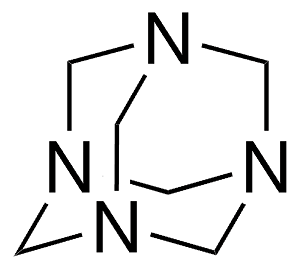Pharmaceutical & Fine Chemicals
Hexamethylenetetramine

Product Description
Hexamethylenetetramine (HMTA), also known as hexamine or methenamine, is a versatile organic compound with numerous industrial applications.
Product:
Hexamethylenetetramine
CAS:
100-97-0
Synonym:
Hexamine; Methenamine; Urotropine
Structure:

Typical Characteristics
Appearance
White crystalline powder
Boiling point
280 °C
Density
1.33 g/cm3
Melting point
263 °C (sublm)
Molecular Weight
140.19
Odor
Odorless
Purity
≥99%
Refractive index
1.590
Uses, Applications & Markets
Key applications
get a quote
We Offer Hexamethylenetetramine
in various grades
A few of the grades available are listed below:



Hexamethylenetetramine used in many
industry applications
Hexamethylenetetramine (HMTA), also known as hexamine or methenamine, is a versatile organic compound with numerous industrial applications. Here are some of its common uses:
- Pharmaceuticals: HMTA is used in the pharmaceutical industry as a precursor for various drugs, including antibiotics, antiseptics, and antimalarial medications. It serves as a building block in the synthesis of pharmaceutical intermediates and active pharmaceutical ingredients (APIs).
- Resin Curing Agent: It is widely employed as a curing agent or hardener in the production of phenolic resins, urea-formaldehyde resins, and melamine-formaldehyde resins. HMTA reacts with formaldehyde under acidic conditions to form crosslinked polymer networks, imparting heat resistance and durability to the resins.
- Explosives: HMTA is a key ingredient in the production of explosives, particularly RDX (cyclotrimethylenetrinitramine) and HMX (cyclotetramethylenetetranitramine). These high-energy materials are used in military applications, mining operations, and demolition work due to their explosive power and stability.
- Animal Feed Additive: It is utilized as a feed additive for livestock and poultry to prevent urinary tract infections and improve urinary health. HMTA decomposes in the acidic environment of the urinary tract, releasing formaldehyde, which exhibits antibacterial properties and reduces the risk of infection.
- Water Treatment: HMTA is employed in water treatment applications as a biocide and disinfectant to control microbial growth in cooling water systems, swimming pools, and industrial wastewater. It effectively inhibits the growth of algae, bacteria, and fungi, preventing biofouling and corrosion.
- Photographic Chemicals: It is used in the photographic industry as a stabilizer and preservative for developing solutions and fixers. HMTA helps maintain the pH balance and chemical stability of photographic processing solutions, ensuring consistent performance and image quality.
- Textile Chemicals: HMTA is employed in the textile industry as a shrinkage reducer and crease-resistant agent for wool and synthetic fibers. It reacts with acidic residues in fabrics to form crosslinks, minimizing shrinkage and improving the dimensional stability of textiles during washing and wear.
- Fuel Additive: It is added to solid rocket propellants and fuel tablets to improve combustion efficiency and reduce smoke emissions. HMTA serves as a binder and combustion catalyst, facilitating the decomposition of fuel components and enhancing thrust performance.
- Adhesives and Sealants: HMTA is used as a curing agent in the formulation of adhesives, sealants, and rubber compounds. It promotes crosslinking reactions between polymer chains, resulting in strong, durable bonds and improved resistance to heat, chemicals, and weathering.
- Chemical Synthesis: HMTA serves as a versatile building block in organic synthesis for the preparation of various nitrogen-containing compounds, including dyes, pigments, surfactants, and corrosion inhibitors. It undergoes reactions such as Mannich condensation, Gabriel synthesis, and reductive amination to form complex organic molecules.